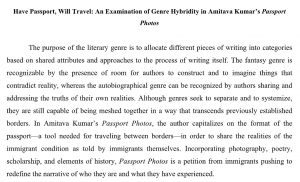If the atom is the smallest unit of the universe, may the all-nighter be the smallest unit of a college student’s academic career.
An amalgam of unfinished assignments, fast-approaching deadlines, and a rush of desperation to both finish and to not fail, the all-nighter lights a fire under your rickety padded wooden chair.
In the fall of 2019, I took ENGL250, an English course dedicated to self-representation. While I was in the class, I had to write an essay that analyzed how a piece of literature displayed genre hybridity. For example, Incidents in the Life of a Slave Girl, a memoir by former slave Harriet Jacobs, displays genre hybridity by combining elements of memoir (it’s an autobiography) and fictional drama (the piece uses pseudonyms for everyone mentioned in the book, including Jacobs herself.
I wrote my paper on Passport Photos, a book by Indian author Amitava Kumar. Passport Photos discusses life as an immigrant while incorporating elements of various mediums such as personal memoir, scholarly research, photography, and poetry. I chose to write about the book because I thought its content was both creative and shrewd. I had never read a book that involved so many mediums of expression, nor had I ever gained so much insight into what it means to call multiple places ‘home’.
When I chose to write my paper on Passport Photos, I was already behind in terms of reading materials for ENGL250.
I had yet to read both Passport Photos and a separate novel, and I had forgone reading the latter so I could spend more time reading Passport Photos. Even then, I realized I was in crunch time when it came to both reading and writing about the book. I spent two days reading and annotating the book, followed by two all-nighters that involved both outlining and revising my paper.
The night of the paper’s due date, I rushed to add some final adjustments and corrections before handing it in. I knew I should’ve started working on my paper sooner, but at this point in time, I preferred to stay focused on the fact that I was working on it now. After a few minutes past midnight, I submitted my paper with bated breath, my heart refusing to beat again until I had confirmation that my paper was successfully submitted.
(Fun fact: I was washing laundry that same night, so I had to alternate between editing my essay and going downstairs to throw my clothes into the washer, dryer, then into my laundry bag so they could be folded in my room.)
For a week or so since I submitted my ENGL250 paper, I felt less stressed knowing that I had one less assignment to worry about. I had only felt anxious when my professor had sent me feedback on my paper.
Could she tell that I had rushed the paper? Did I make irrevocable grammar mistakes? Had I just jeopardized my entire college career?
The answer is no. As I scrolled down to see my professor’s red rhetoric of redemption, I learned that I had apparently constructed quite the masterpiece:
If there’s anything to learn from this story, let it be that all-nighters are both exhilarating and exhausting.
The experience of cramming to write 1,000 words kept me up for hours, but so did my unnerving fear of receiving an poor grade for poor productivity.
Although my efforts paid off tremendously, I realized I could not sustain consistent all-nighters (even if that’s how I approached later papers). I deserved better for my mental health, my creative muscles, my thinking muscles, and my overall well-being.
Writing an essay is quite similar to building a house.
Would you rather live in a house whose structure was repeatedly outlined and refined before and during construction, or a house whose structure seems sturdy but could easily collapse with a single glitch?
Success requires care and respect for one’s work. Spend some time—but not too much time—thinking about your project. Assemble an outline. Edit the outline. Revise the outline. Let the outline sit for a bit. Come back and write a full draft. Leave the draft. Come back to edit and revise. Write a second draft. Leave the second draft. Come back to edit and revise.
Give your work time to breathe and time to grow.
Most importantly?
Give yourself time to breathe and time to grow.
(featured image credit: @samuelsparkle via unsplash.)


